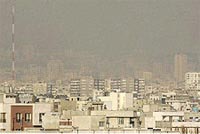 |
|
Fog in Tehran in December 2005 |
According to Nature magazine, European researchers have discovered a previously unknown source of pollution that emits nitrogen oxides, a gas contributing to smog in sunlit cities.
When exposed to light, nitrogen dioxide (originating from the combustion of automobile engines, coal-fired power plants, and heating systems) reacts with moisture and organic compounds decomposing into humus, creating this polluting gas. The moisture comes from the decomposition of organic materials found everywhere on Earth’s surface, whether in natural environments or heavily impacted human areas.
Researchers from Wuppertal University (Germany), Paul Scherrer Institute (Switzerland), and the Villeurbanne Environmental Chemistry Laboratory (France) suggest that the excessive production of nitrogen oxides can severely affect the troposphere, the lowest, densest, and most polluted layer of the atmosphere.
For the past 20 years, it has been known that the degradation of nitrogen oxides by light releases hydroxyl radicals, which affect the production cycle of ozone gas. This phenomenon of excessive nitrogen oxides production could be responsible for emitting half of the hydroxyl radicals.
Unlike ozone in the stratosphere, which benefits from filtering harmful ultraviolet rays from the sun, ozone in the lower atmosphere is a serious air pollutant. It contributes to the formation of light yellow photochemical smog, irritating mucous membranes, eyes, and respiratory tracts, and is commonly found in sunny cities.


















































